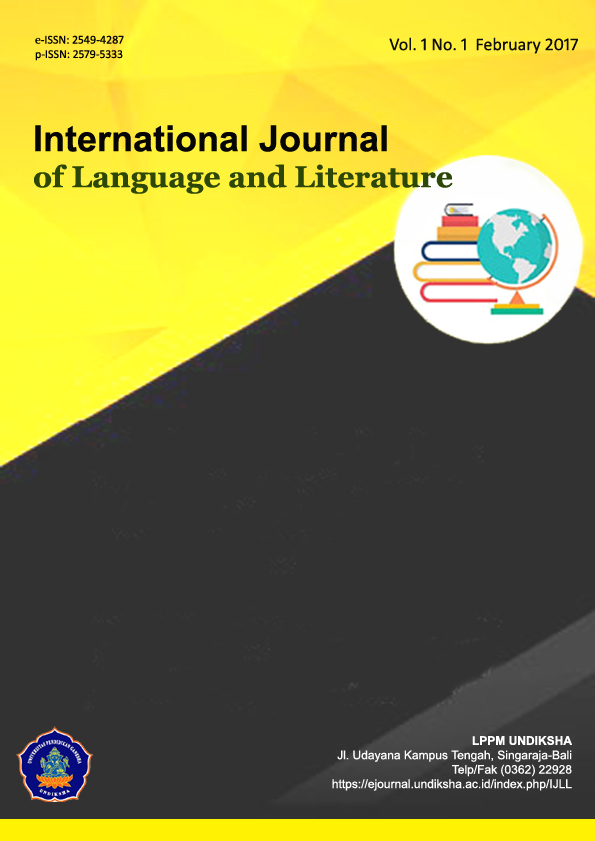DERIVATIONAL AND INFLECTIONAL PREFIXES AND SUFFIXES IN BATUSESA DIALECT OF BALINESE: A DESCRIPTIVE STUDY
DOI:
https://doi.org/10.23887/ijll.v1i1.9617Keywords:
prefixes, suffixes, derivational, inflectionalAbstract
This study was designed in the form of descriptive qualitative study with the aim at describing the prefixes and suffixes in Batusesa Dialect of Balinese which belong to derivational and inflectional morpheme. The techniques used to collect the data were observation, recording and interview technique. In this study, there were three informants chosen. The results of this study show that there are four kinds of prefixes found in Batusesa Dialect, namely {n-}, {me-}, {pe-}, and {a-} and five kinds of suffixes namely {-ang}, {-nә}, {-in}, {-an} and {-ә}. There are three kinds of prefixes and one kind of suffixes which belong to derivational morpheme, namely {n-}, {me-}, {pe-}, and {-ang}. Moreover there are three kinds of inflectional prefixes namely {n-}, {me-}, and {a-} and four kinds of suffixes which belong to inflectional morpheme, namely {-nә}, {-in}, {-an} and {-ә}. There were some grammatical functions of prefixes and suffixes in Batusesa dialect of Balinese, namely affix forming verbal, affix forming nominal, affix forming numeral, affix forming adjective, and affix forming adverb, activizer and passivizer.
References
Abdussalam & Mahmud, S. (2014). Gayo Language Is Old Malay (A Dialectology Study: The Language Change). Englisia, 1(2), 191-215. Retrieved from http://jurnal.ar-raniry.ac.id/index.php/englisia/article/download/28/23
Affifah, R. (2012). Word Formation Process in Slank Word Used by Transsexual . Retrieved from: https://core.ac.uk/download/pdf/11733666.pdf
Aronoff, M. & Fudeman, K. (2011). What is Morphology?. Retrived from http://www.ucd.ie/artspgs/introling/Aronoffmorphology.pdf
Brett, D. (2013).Derivational and inflectional morphemes. Retrieved from http://davidbrett.uniss.it/morphology/derivInflect.html
Budasi, I. G. (2007). Kekerabatan bahasa-bahasa di sumba (suatu kajian linguistik hipotesis, komperatif (disertasi). Yogyakarta: Fakultas Pascasarana Universitas Gajah Mada.
Carstairs, A. & McCarthy, (2002). An Introduction of Morphology. Retrieved from http://logic.sysu.edu.cn/ebookfull/UploadFiles_7160/200905/2009050617095579.pdf
Chaer, A. (2003). Linguistik Umum. Jakarta: PT Rineka Cipta.
Chaer, A.2015. Morpologi bahasa Indonesia (pendekatan proses). Jakarta: Rineka Cipta.
Enrilefariz, (2015).What is the Morphology? (EN/INA). Retrived from https://enrilefariz.wordpress.com/2015/12/27/what-is-the-morphology/
Fazaelly, S. (2013). A Study on the Affixation Process of Sadeq Hedayat’s and Jalal Al-e Ahmad’s Works. Retrieved from http://ijee.org/yahoo_site_admin/assets/docs/8.89113418.pdf
Ghozali, A. (2014). morphological process. Retrieved from http://www.slideshare.net/ghozaliaffan/morphological-process.
Haspelmath, M. & Sims, A D. (2010). Understanding Morphology. Retrieved from http://202.121.96.130/download/20140401232730644.pdf
Hosseinzadeh at all, 2014. The Assimilation of Consonants in Eghlid, an Iranian Dialect. Retrieved from http://www.eajournals.org/wp-content/uploads/The-Assimilation-of-Consonants-in-Eghlid-an-Iranian-Dialect1.pdf
http://www.kul.pl/files/30/UW/06Morphology-class-handout.pdf morphology 66
Ingo, P. (2002). Word-formation in English. Retrived from http://www2.uni-siegen.de/~engspra/plag-in-press.pdf
Jaten, I ketut. ( 2010). Pura Pelawangn Agung Batusesa. Denpasar. Paramita
Jendra, at all. (1977). Morpologi Bahasa Bali. Denpasar:Univesitas Udayana
Kridalaksana, H. (1996). Pembentukan Kata Dalam Bahasa Indonesia, Edisi kedua. Jakarta: Gramedia Pustaka Utama.
Kridalaksana,H. (2007). Pembentukan Kata DalamBahasa. Jakarta: GramediaPustakaUtama.
Mahadwipa, K. A. (2012). A Morphophonemic Analysis of Balinese Affixes of Madenan Dialect. Singaraja: Universitas Pendidikan Ganesha.
Mantra, I. K. (2014). An Analysis of Derivational and Inflectional Morpheme in Nusa Penida Dialect. Singaraja: Universitas Pendidikan Ganesha.
Miles, M. W. & Huberman, A. M. Qualitative Data Analysis (2nd ed.) London: Sage Publications.
Moradi, Rasool. (2014). Derivation and Inflection in Laki. International Journal of Management and Humanity Sciences, 3 (12), 3832-3836. Retieved from http://ijmhsjournal.com/wp-content/uploads/2015/01/3832-38361.pdf
Nordquist, R. (2015). derivational morpheme (words and word parts). Retrieved fromhttp://grammar.about.com/od/d/g/Derivational-Morpheme.html
Oiry, (2009). morphology. retrived from http://people.umass.edu/moiry/morphology.pdf
Parera, J. D. (2007). Morfologi. Jakarta: PT Gramedia Pustaka Utama.
Parker, Mattew D. 2005. A Comparative Study Between Mean Length of Utterances in Morphemes. Retrieved from http ://www.researchgate.net
Quinion, M (2009). Affixes: the building blocks of English. Retrived from http://www.affixes.org/typesofaffix.html
Riasa, I M. L. (2015).Affixation in Lemukih Dialect of Balinese: a Descriptive study of Derivitional and InfluctionalProcess.Singaraja: Universitas Pendidikan Ganesha.
Samarin, W.J. (1967). Field Linguistic: A Guide to Linguistic Filed Work. United State: Hold Rinehartan Wiston.
sandhyadwaya, (2013). Dialect Bahasa Bali. Retrieved from https://sandhyadwaya.wordpress.com/2013/08/21/dialek-basa-bali/
Sari, N. (1988). An Introduction to Linguistics. Jakarta: Proyek Pengembangan Lembaga Pendidikan Tenaga Kependidikan (P2LPTK).
Umera-Okeke, N. (2007). Exploring Affixation in English. Retrieved from file:///C:/Users/acer/Downloads/41010-19496-1-PB.pdf.
Vikram, Shweta. (2013). Morphology: Indian Languages and European Languages. International
Downloads
Published
How to Cite
Issue
Section
License
IJLL Journal provides immediate open access to its content on the principle that making research freely available to the public to supports a greater global exchange of knowledge.

This work is licensed under a Creative Commons Attribution-ShareAlike 4.0 International License








